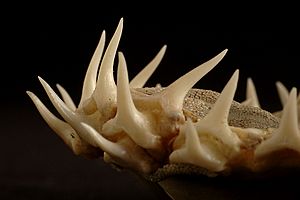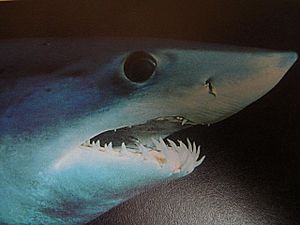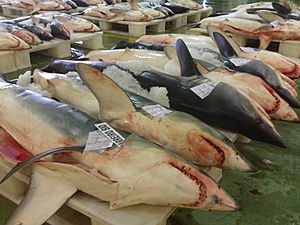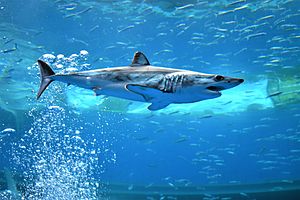Shortfin mako shark facts for kids
Quick facts for kids Shortfin mako shark |
|
|---|---|
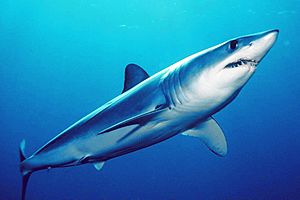 |
|
| Conservation status | |
| Scientific classification | |
| Genus: |
Isurus
|
| Species: |
oxyrinchus
|
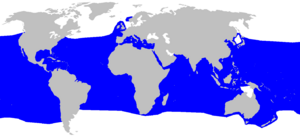 |
|
| Distribution of Isurus oxyrinchus | |
| Synonyms | |
|
click to expand
Isurus oxyrhinchus Rafinesque, 1810
Isurus oxyrhincus Rafinesque, 1810 Isurus oxyrhynchus Rafinesque, 1810 Isurus spallanzani Rafinesque, 1810 Squalus cepedii Lesson, 1831 Isurus cepedii (Lesson, 1831) Lamna oxyrhina Cuvier & Valenciennes, 1835 Oxyrhina gomphodon Müller & Henle, 1839 Oxyrhina glauca Müller & Henle, 1839 Isuropsis glaucus (Müller & Henle, 1839) Isurus glaucus (Müller & Henle, 1839) Lamna glauca (Müller & Henle, 1839) Lamna latro Owen, 1853 Isuropsis dekayi Gill, 1862 Carcharias tigris Atwood, 1869 Isurus tigris (Atwood, 1869) Lamna guentheri Murray, 1884 Isurus guentheri (Murray, 1884) Lamna huidobrii Philippi, 1887 Isurus mako Whitley, 1929 Isuropsis mako (Whitley, 1929) Isurus bideni Phillipps, 1932 Isurus tigris africanus Smith, 1957 Isurus africanus Smith, 1957 Lamna punctata (non Storer, 1839) misapplied Isurus paucus (non Guitart Manday, 1966) misapplied |
|
The shortfin mako shark (Māori: Isurus oxyrinchus) is a very fast shark. It is also called the blue pointer or bonito shark. People often just call it the mako shark. Another shark, the longfin mako shark, is also called a mako. Shortfin mako sharks can grow up to 4 meters (13 feet) long. They can weigh as much as 570 kilograms (1,257 pounds). The IUCN says this shark is an endangered species. This means it is at high risk of becoming extinct.
Contents
Understanding the Name "Mako"
The word "Mako" comes from the Māori language of New Zealand. It means either the shark itself or a shark tooth. In Māori, "mako" can be used for both one shark and many sharks. The word is similar to shark names in other Polynesian languages. For example, it's mangō in other Māori dialects. It's "mago" in Samoan and mano in Hawaiian.
The first time "Mako" was written down was in 1820. A book called Grammar and vocabulary of the language of New Zealand simply said, "Máko; A certain fish". Later, in 1848, another book added more detail. It said, "Mako, the shark which has the tooth so highly prized by the Maoris".
In 1809, Constantine Samuel Rafinesque gave the shortfin mako its scientific name. This name is Isurus oxyrinchus. The word isurus means "the same tail". The word oxyrinchus means "pointy snout".
About the Shortfin Mako Shark
The shortfin mako shark is a large shark species. It grows faster than some other sharks in its family. An average adult shark is about 2.5 to 3.2 meters (8 to 10.5 feet) long. It usually weighs between 135 and 230 kilograms (298 to 507 pounds). Female sharks are usually larger than males. Some very large females can be over 3.8 meters (12.5 feet) long. They can also weigh more than 550 kilograms (1,213 pounds).
The largest shortfin mako caught by hook and line weighed 600 kilograms (1,323 pounds). This shark was caught off California in 2013. The longest shark ever measured was 4.45 meters (14.6 feet) long. It was caught off France in 1973. There are stories of even bigger makos, but these are harder to prove.
Appearance of the Mako Shark
The shortfin mako shark has a body shaped like a cylinder. Its tail is tall and thin. It has a special type of camouflage called countershading. This means it is bright metallic blue on top and white underneath. The line where the blue and white meet is very clear. The area around its mouth and under its snout is white.
Bigger sharks tend to have darker colors. These darker colors can spread to parts of their body that are white in smaller sharks. Young mako sharks have a blackish mark on the tip of their snout. The longfin mako shark looks a lot like the shortfin mako. However, the longfin has bigger fins and darker colors around its mouth. It also has larger eyes.
You can tell a mako shark apart from other similar sharks. It has only one keel (a ridge) on its tail. Also, its teeth do not have small points on the sides.
Where Shortfin Mako Sharks Live and What They Eat
Home and Habitat
Shortfin mako sharks live in the open ocean. They are found in temperate and tropical waters around the world. The longfin mako shark prefers warmer waters, like the Gulf Stream.
These sharks are pelagic species. This means they live in the open water, not near the bottom or shore. They can be found from the surface down to about 150 meters (490 feet) deep. They usually stay far from land. However, sometimes they come closer to islands or bays. Mako sharks are one of the few sharks that can keep their bodies warmer than the water. They are rarely found in waters colder than 16°C (61°F).
In the western Atlantic, they live from Argentina up to Nova Scotia. They are not super common in Canadian waters, but they are not rare either. If you find swordfish, you might find mako sharks. This is because swordfish are a food source for makos. Both species also like similar ocean conditions.
Mako sharks travel very long distances. They do this to find food or mates. One female shark tagged off California traveled over 2,776 kilometers (1,725 miles). Another shark swam 2,128 kilometers (1,322 miles) in just 37 days. That's about 58 kilometers (36 miles) every day!
What Mako Sharks Eat
The shortfin mako shark mainly eats squid and other fish. These fish include mackerels, tunas, bonitos, and swordfish. But they also eat other sharks, porpoises, sea turtles, and seabirds. They hunt by swimming below their prey. This way, they can see what's above them. Then they lunge upwards and bite off pieces of their prey's body or fins.
Sometimes, mako sharks are found with swordfish bills stuck in their heads. This suggests that swordfish can seriously hurt or even kill them. This often happens when swordfish are laying eggs. This is a time when swordfish are most vulnerable.
Mako sharks eat about 3% of their body weight each day. It takes them about 1.5 to 2 days to digest a meal. This is much faster than slower sharks. For example, a sandbar shark takes 3 to 4 days to digest its food. Studies show that mako sharks in some areas love to eat bluefish. Bluefish make up a big part of their diet.
Larger mako sharks, over 3 meters (10 feet) long, have wider, flatter teeth. These teeth help them hunt bigger prey. This includes dolphins, swordfish, and other sharks. Mako sharks also sometimes eat fish that have been caught on fishing lines or in nets.
The bite of a shortfin mako shark is very strong. In 2020, a mako shark in New Zealand had its bite force measured. It bit a special device with about 13,000 newtons of force. That's about 3,000 pounds of force!
Mako sharks are very fast because they can keep their bodies warm. Like other sharks in their family, they have a special blood system. This system keeps their body temperature 7 to 10°C (13 to 18°F) warmer than the water. This helps them stay very active. It gives them an advantage over their cold-blooded prey.
Mako Shark Behavior
The shortfin mako is known for its speed. When caught on a fishing line, it can leap high into the air. This makes it a popular game fish for sport fishing around the world. There have even been a few times when a hooked mako shark jumped right into a boat!
Mako Shark Reproduction and Life Cycle
The shortfin mako shark gives birth to live young. This is called ovoviviparous. Inside the mother, the baby sharks eat unfertilized eggs. This happens during the 15 to 18 months that they grow. Unlike some other sharks, they do not eat their brothers and sisters.
Between 4 and 18 young sharks are born alive. They are about 70 centimeters (2.3 feet) long when they are born. This usually happens in late winter or early spring. Female sharks might take a break for 18 months after giving birth. Then they will mate again. Shortfin mako sharks usually have babies every three years.
Female mako sharks often mate with more than one male. This is called polyandry. It means that one group of baby sharks can have different fathers. This is a common way for many animals to reproduce.
How Long Mako Sharks Live
Scientists can tell a shark's age by looking at its vertebrae. These are the bones in its spine. They count the growth rings, much like counting rings on a tree. For a long time, people thought mako sharks grew two rings a year. This made them think makos lived shorter lives.
But in 2006, a study showed that mako sharks only grow one ring per year. This changed what we know about them. The study found:
- Male makos can live up to 29 years.
- Female makos can live up to 32 years.
- Males become ready to have babies around 8 years old.
- Females become ready to have babies around 18 years old.
Because of the old mistake, some models used to manage shark fishing were wrong. They thought makos matured much faster and lived shorter lives. This was especially true for females.
Mako Shark Intelligence
The shortfin mako shark has one of the largest brains compared to its body size among all sharks studied. Because of this, scientists have looked into how smart they are. Researchers have done tests to see if makos can tell shapes apart. They also tested their ability to sense electricity.
These studies showed that shortfin mako sharks learn quickly. They can figure out if people are a threat or not. The sharks in the study, after being careful at first, started acting in new ways. For example, they didn't roll back their eyes when eating bait. They even let researchers briefly touch them while being fed.
Mako sharks don't rely on sensing electricity to hunt as much as great white sharks do. Instead, they use their sense of smell, hearing, and especially their vision. This research was shown in a TV show called Mako: Swift, Smart & Deadly.
Mako Sharks and Humans
Sport Fishing for Mako Sharks
Fishing for mako sharks is popular around the world. Because they are so fast, they put on an amazing show. They can jump and make fast runs. This makes them exciting for people who like to fish. Usually, people use bait and special fishing reels to catch them. But now, some people are trying to catch them with fly fishing. This is especially popular in San Diego, California.
For many years, large fishing boats caught makos for restaurants. But now, many local fishing companies and groups are working to reduce this. They want to protect the sharks.
Mako Sharks in Aquariums
It is very hard to keep shortfin mako sharks in aquariums. They do not do well in captivity. Even other large open-ocean sharks like the great white shark have done better. In the 1970s, a mako shark at SeaWorld San Diego died quickly. It couldn't handle hitting the walls of the tank.
The longest a shortfin mako has lived in an aquarium is only five days. This happened at the New Jersey Aquarium in 2001. The shark seemed strong when it arrived. But it had trouble with the tank walls, wouldn't eat, got weak, and then died.
Mako Shark Attacks on Humans
Records show that between 1580 and 2022, there were 9 shortfin mako shark attacks on humans. Three of these attacks were deadly. There were also 20 attacks on boats. Mako sharks are powerful and fast. They are certainly able to hurt or kill people. However, they usually do not attack humans. They don't seem to see humans as food.
Most modern attacks by shortfin mako sharks happen because the shark was provoked. This means someone bothered the shark or it was caught on a fishing line. Sharks might be attracted to spear fishermen carrying a fish they just caught. Divers who have met mako sharks say that before an attack, the shark might swim in a figure-eight pattern. It might also approach with its mouth open.
Protecting the Shortfin Mako Shark
The IUCN now lists the shortfin mako as an Endangered species. This means it is at high risk of extinction. It was moved from "Vulnerable" in 2019 and "Near-Threatened" in 2007. The species is also on a list called Appendix II of CITES. This list helps control the international trade of endangered animals.
Mako sharks are caught by both sport fishermen and large fishing boats. Many are also caught by accident in nets meant for other fish. This is called bycatch. In 2018, New Zealand's Department of Conservation said the shortfin mako shark was "Not Threatened" in their waters. But they added "Uncertain whether Secure Overseas". This shows that the shark's future depends on what happens in other parts of the world.
See also
 In Spanish: Tiburón mako para niños
In Spanish: Tiburón mako para niños




